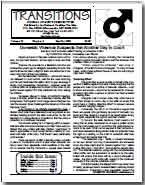 Research into the roots of our species suggests that stronger bonds between fathers and their children played a role in shaping society as we know it — which is a worthwhile subject for reflection on this Father’s Day weekend. Some anthropologists even suggest that current social trends could bring us closer to the good old days of hunter-gatherer fathering.
Research into the roots of our species suggests that stronger bonds between fathers and their children played a role in shaping society as we know it — which is a worthwhile subject for reflection on this Father’s Day weekend. Some anthropologists even suggest that current social trends could bring us closer to the good old days of hunter-gatherer fathering.
Although most moms wish the man in the house would take more of a role in childraising, things could be worse. Males take on the job of parental care in only 5 percent of mammalian species, according to research cited in “Fatherhood: Evolution and Parental Behavior.” In that book, anthropologists Peter Gray of the University of Nevada at Las Vegas and Kermyt Anderson of the University of Oklahoma tick off several facts about the evolution of fatherhood:
- Men tend to spend more time with young children in hunter-gatherer societies than they do in most other societies, particularly ones in which men make a living herding livestock. “Fathers might have sex-specific reasons for spending time with children, for instance, teaching boys to hunt,” Gray and Anderson wrote in The Chronicle Review.
- Men tend to invest more in children if they are the biological parents rather than the stepparents. “Spending time on offspring who do not carry any of your genes seems counterintuitive,” the anthropologists said.
- Some studies have shown fathers tend to have lower testosterone levels than men without children in the same society. “This could be picking up the behavioral transition men undergo as fathers as they move away from some degree of investment in courting women, seeking new mates, competing with other males, and begin to settle into a more family-oriented outlook, including spending time directly with a young child,” Gray told the Boston Globe.
- Paternal care is largely absent among our primate cousins, and the fossil record suggests that the common ancestors of humans and chimpanzees were similarly fatherhood-deficient.
So what changed? Anthropologists say the rise of male-female pair bonding was a key factor. “We see that process getting under way around 2 million years ago but becoming more pronounced around a half a million years ago,” Gray and Anderson write. With pair bonding, males had a bigger stake in defending their mates as well as their genetic progeny.
When fathers invested more time in nurturing the family group, the mothers didn’t have to expend as much energy — and that opened the way to more frequent births and bigger families. At least that’s the hypothesis advanced by Northwestern University’s Lee T. Gettler in the journal American Anthropologist. That, in turn, led to a population explosion among the early members of the Homo genus.
How males gathered together
Other research suggests that early humans diverged from chimps in the organization of hunter-gatherer societies. Groups of chimpanzees are generally organized along kinship lines, and there’s a high level of aggression between those kin groups. But Arizona State University anthropologist Kim Hill and his colleagues reported in the journal Science that today’s human hunter-gatherer groups are more mixed up, genetically speaking.
Such intermixing, coupled with pair bonding, might well explain why intergroup relations go more smoothly among humans than they do among chimps (even though we still have a long way to go). A father who recognized his son in a neighboring group would be less likely to strike out against him, which would open the way for larger tribal networks. (Thanks to Blogging the Bust’s James Lavin for making the connection to fatherhood.)
Last month, University of Colorado anthropologist Sandi Copeland and her colleagues published a paper in the journal Nature suggesting that hominid males tended to be stay-at-home types who stuck together as far back as 2 million years ago. The researchers’ conclusions, based on an analysis of fossil teeth found in South African caves, lend weight to the idea that cooperative behavior among males was one of the hallmarks of hominid society.
The takeaway message is that fatherhood and male bonding took on a higher profile in the formation of hominid hunter-gatherer societies, even before the rise of Homo sapiens — and that those aspects contributed to the organization of early human society, on a scale that could be larger than that found among other primates to this day.
Modern-day message
So what does that mean for modern-day fathers? You could argue that we’re taking on more of the aspects of a hunter-gatherer social setting thanks to some of the trends we’re seeing today — more women in the workplace, more stay-at-home dads, blurred roles in childrearing, a departure from industrial work patterns, even increased connectedness through mobile devices.
Gray told the Globe that today’s society may be friendlier to fatherhood than the family setting in the 1960s, portrayed so vividly (and unflatteringly) in shows such as “Mad Men.” In short, this is not your father’s fatherhood.
“One thing presented in a show like ‘Mad Men’ that was also a common family pattern in the baby-boom era in the U.S. is this sexual division of labor,” Gray said. “Women were at home and didn’t work. That does not apply well to an evolutionary backdrop. Among hunter-gatherers, women and men are both working, but in ways compatible with having young kids.”
Has fatherhood evolved, or are we still cavemen when it comes to parenting? Feel free to weigh in with your comments below … and have a great Father’s Day!
More about the science of fatherhood:


